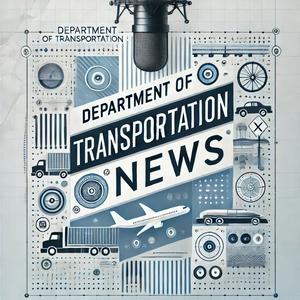149 episodes

DOT Cracks Down on Trucker Licenses, Pilots Flexible Hours
2026/1/09 | 3 mins.
You’re listening to the DOT Dispatch, where we break down what’s happening in transportation and why it matters to you.The big headline this week: the U.S. Department of Transportation is yanking about 160 million dollars in highway funding from California after the state failed to cancel more than 17,000 illegally issued commercial trucking licenses by a federal deadline. According to the Federal Motor Carrier Safety Administration, California agreed in November to revoke those licenses within 60 days but missed the January 5 cutoff. Transportation Secretary Sean P. Duffy put it bluntly, saying it’s “reckoning day” for the state and that federal tax dollars will not “fund this charade.” FMCSA chief Derek Barrs warned they will not accept any plan that leaves thousands of noncompliant drivers behind the wheel of 80,000‑pound trucks.So what does that mean for you? For everyday Americans, DOT is framing this as a road safety move: fewer unvetted drivers operating big rigs, and more pressure on states to clean up their licensing systems. For trucking companies and logistics firms, this is a wake‑up call that driver credentialing is now a frontline enforcement issue. California could see delays in highway projects as that 160 million dollars is withheld from key programs, forcing state and local governments to reshuffle budgets or postpone upgrades. And for other states, this is a very public warning: fall out of compliance on commercial licenses and your federal money is on the line.Zooming out, DOT is pairing this enforcement push with new initiatives aimed at truckers. FMCSA just launched two national pilot programs—the Split Duty Period and Flexible Sleeper Berth pilots—to test more flexible hours‑of‑service options. The agency expects more than 500 commercial drivers to take part starting in early 2026, gathering real‑world data on whether giving drivers more control over when they rest can improve both safety and quality of life. These pilots could reshape daily schedules for carriers and drivers, and FMCSA is actively inviting public comment, so this is a chance for drivers, small fleets, and safety advocates to weigh in before any permanent rule changes.If you’re a citizen, your voice matters here: you can submit comments on these pilots and on enforcement policies through Regulations.gov and follow updates on the DOT and FMCSA websites and social channels. Businesses should be reviewing their driver vetting and compliance systems now, especially if they operate across multiple states. State and local agencies will be watching the California funding hit closely as they plan their own transportation budgets and safety programs.In the weeks ahead, keep an eye on how California responds to the funding cutoff, on any follow‑up crackdowns in other states, and on FMCSA’s next steps as those driver‑flexibility pilots gear up and public comments come in.Thanks for tuning in, and don’t forget to subscribe so you never miss an update. This has been a quiet please production, for more check out quiet please dot ai.For more http://www.quietplease.aiGet the best deals https://amzn.to/3ODvOtaThis content was created in partnership and with the help of Artificial Intelligence AI

Transportation Secretary Duffy slashes regulations, boosts trucking and tech for safer roads
2026/1/05 | 1 mins.
Welcome to your weekly DOT update, where we cut through the red tape to spotlight what's changing on America's roads and rails.This week's blockbuster: Transportation Secretary Sean P. Duffy just slashed 52 deregulatory actions across FHWA, NHTSA, and FMCSA, easing burdens on trucking fleets and highways. As CNS Protects reports, it's part of a regulatory realignment under Trump—fewer mandates, more tech-forward tweaks like autonomous truck rules by May 2026 and flexible hours-of-service pilots launching early next year.Key moves include a massive crackdown on non-domiciled CDLs, yanking over 90,000 invalid licenses after crashes and audits—forcing California to pause or lose funding. FMCSA's also modernizing: no more ELD manuals in cabs, electronic DVIRs okay, and ag haulers get clearer HOS exemptions by 2026. NHTSA's delaying school bus child restraint rules to December 2026, exempting some for safety. Duffy launched the "Make Travel Family Friendly Again" campaign with $1 billion in funding.For everyday drivers and citizens, this means safer roads—fewer unqualified truckers, dynamic emergency lanes rolling out this month to speed ambulances. Businesses gain paperwork relief and pilot flexibility for 500-plus drivers, boosting efficiency without skimping safety. States like California face funding squeezes, pushing compliance.Duffy says, "We're slashing red tape to keep families moving safely." Data backs it: DOT aims to cut roadway fatalities to under 36,458 by 2026.Watch FMCSA's ADS truck rule NPRM in May and HOS pilots soon—comment now at transportation.gov. Check your state's DMV for digital licenses and toll upgrades hitting roads this January.Stay ahead: visit transportation.gov for details and submit input on pilots.Thanks for tuning in, listeners—subscribe for more. This has been a Quiet Please production, for more check out quietplease.ai.For more http://www.quietplease.aiGet the best deals https://amzn.to/3ODvOtaThis content was created in partnership and with the help of Artificial Intelligence AI

Trucking Flexibility, Safety Tech, and Infrastructure Shifts in DOT's Pro-Trucker Package
2026/1/02 | 2 mins.
Welcome to your weekly DOT Dispatch, where we break down the biggest moves from the U.S. Department of Transportation shaking up how we travel.This week's top headline: Transportation Secretary Sean P. Duffy launched the Pro-Trucker Package, including pilot programs for Split Duty Periods and Flexible Sleeper Berth options. These let truckers pause their 14-hour driving window for 30 minutes to three hours or tweak rest splits beyond the usual 8/2 or 7/3 setups. As Duffy put it in the FMCSA announcement, it's about "enforcing commonsense rules of the road" under President Trump's Executive Order 14286, with protocols kicking off early 2026 and over 500 drivers joining.Key developments are piling up fast. FMCSA's cracking down hard on non-domiciled CDLs after fatal crashes, yanking an estimated 90,000 nationwide with new visa checks and annual renewals—California even paused its program or risked federal highway funds, per CNS Protects reports. They're rolling out the MOTUS registration system for secure, glitch-free trucking data, and Amazon's tightening enforcement on carrier violation rates by February 2026. Look for autonomous truck rules by May, expanded Drug & Alcohol Clearinghouse access, looser seizure standards for drivers, and paperwork cuts like ditching ELD manuals in cabs.For everyday Americans, this means safer roads with fewer unqualified drivers and smarter tech like dynamic emergency corridors rolling out in major cities from January, per road update guides—potentially faster ambulance responses but some DMV lines for digital licenses. Truckers and businesses gain flexibility and less red tape, boosting retention amid tight labor markets, though fleets must invest in safety tech or lose gigs. States like California face pressure on speed limits and AV enforcement starting July, while the FY2026 BUILD grants signal billions for local infrastructure.Experts note this regulatory realignment under Trump's deregulation push offsets new rules by axing old ones, creating a mixed bag of relief and adaptation.Citizens, check your state's DMV for digital license timelines and comment on pilots at FMCSA notices—public input shapes these.Watch for AV proposals in May and reauthorization talks through September. Dive deeper at transportation.gov or fmcsa.dot.gov.Thanks for tuning in, listeners—subscribe for more. This has been a Quiet Please production, for more check out quietplease.ai.For more http://www.quietplease.aiGet the best deals https://amzn.to/3ODvOtaThis content was created in partnership and with the help of Artificial Intelligence AI

DOT Crackdown on Shady CDLs, Boosting Road Safety and American Manufacturing
2025/12/29 | 3 mins.
Welcome to your weekly DOT Dispatch, where we cut through the noise to spotlight what's shaking up transportation. This week, the biggest headline blaring from the U.S. Department of Transportation is Secretary Sean P. Duffy's fiery crackdown on states issuing illegal commercial driver's licenses to foreign drivers. FMCSA press releases detail audits exposing over 50% of New York's non-domiciled CDLs as bogus, one-third in Minnesota, and violations in Colorado, Pennsylvania, and beyond. Duffy didn't mince words: "If Colorado does not immediately pull these licenses and come into compliance, the state will lose $24 million in federal highway funds," with Pennsylvania facing $75 million on the line and options to decertify entire programs.This enforcement blitz builds on sweeping policy shifts from Duffy's January order, rolling back prior regs for cost-benefit focus, ditching DEI mandates, and tying funding to immigration compliance and Buy America rules, per Holland & Knight analysis. FMCSA also axed nearly 3,000 shady CDL training providers, overhauled Electronic Logging Device vetting to slash fatigue crashes, and pledged training for one million responders during Crash Responder Safety Week.For American citizens, safer roads mean fewer deadly wrecks from unqualified drivers—think reduced fatigue and foreign license scams. Businesses, especially trucking fleets, gain from streamlined ELDs cutting costs and a scrapped speed limiter mandate, but must prep for October's MC-to-USDOT number switch and stricter non-domiciled CDL checks. States like Colorado and New York risk massive funding hits, forcing quick revocations within 30 days or facing audits. No big international ripples yet, but border rail crews now need English proficiency.Duffy announced $33 million in university grants for innovation, $1 billion for safer roads, and $2 billion for U.S.-made transit buses. Watch mid-2025 for FMCSA's full Safety Measurement System launch refining enforcement.Citizens, report suspicious CDLs via FMCSA hotlines. Dive deeper at transportation.gov or fmcsa.dot.gov.Thanks for tuning in, listeners—subscribe for more. This has been a Quiet Please production, for more check out quietplease.ai.For more http://www.quietplease.aiGet the best deals https://amzn.to/3ODvOtaThis content was created in partnership and with the help of Artificial Intelligence AI

DOT Dispatch: Safer Roads, Deregulation, and the Future of Air Mobility
2025/12/26 | 2 mins.
Welcome to your weekly DOT Dispatch, where we cut through the noise to spotlight what's shaking up transportation. This week, the biggest headline is Transportation Secretary Sean Duffy's powerhouse announcement of a $1 billion investment in safer American roads, unveiled December 23, straight from the DOT newsroom. Picture smoother highways, fewer crashes, and families getting home faster—that's the real-world win here.Diving into key moves, Duffy's slashed red tape with 52 deregulatory actions across FHWA, NHTSA, and FMCSA, easing burdens on carriers while keeping safety tight. He's enforcing truck license purges, blasting Colorado for delays and threatening $24 million in withheld funds, with Pennsylvania facing $75 million on the line if they don't revoke illegal foreign-issued CDLs. FMCSA overhauled its Safety Measurement System into just two categories: Vehicle Maintenance and Driver Observed, simplifying tracking for truckers. And on December 17, DOT dropped the Advanced Air Mobility National Strategy, forecasting initial AAM flights by 2027, with Secretary Duffy rallying industry leaders for safe innovation.These shifts hit hard: Everyday Americans see safer drives and innovative air travel without endless regs. Businesses, especially trucking fleets, gain from dropped speed limiter mandates and pro-trucker packages, boosting efficiency. States like Colorado and Pennsylvania must scramble or lose funding, pressuring local governments to align fast. No big international ripples yet, but Buy America rules prioritize U.S. jobs.Duffy said, "We're building big, beautiful infrastructure to make American roads safer." Data backs it: Texas reports the lowest roadway deaths in five years via their 12 Days of Safety push. Watch for rescissions by February 18 and AAM funding calls.Citizens, comment on DOT's site for bridge reconstructions or CDL input. Head to transportation.gov for details.Next up: FMCSA enforcement deadlines and AAM summits. Stay tuned—subscribe now for updates.Thanks for tuning in, listeners. This has been a Quiet Please production, for more check out quietplease.ai.For more http://www.quietplease.aiGet the best deals https://amzn.to/3ODvOtaThis content was created in partnership and with the help of Artificial Intelligence AI
More Government podcasts
Trending Government podcasts
About Department of Transportation (DOT) News
Listen to Department of Transportation (DOT) News, The Tara Palmeri Show and many other podcasts from around the world with the radio.net app

Get the free radio.net app
- Stations and podcasts to bookmark
- Stream via Wi-Fi or Bluetooth
- Supports Carplay & Android Auto
- Many other app features
Get the free radio.net app
- Stations and podcasts to bookmark
- Stream via Wi-Fi or Bluetooth
- Supports Carplay & Android Auto
- Many other app features


Department of Transportation (DOT) News
download the app,
start listening.

















